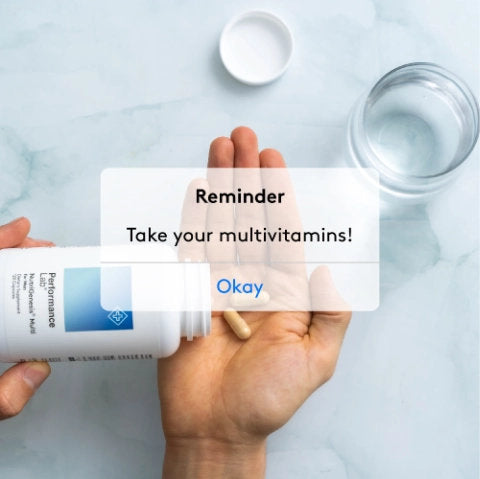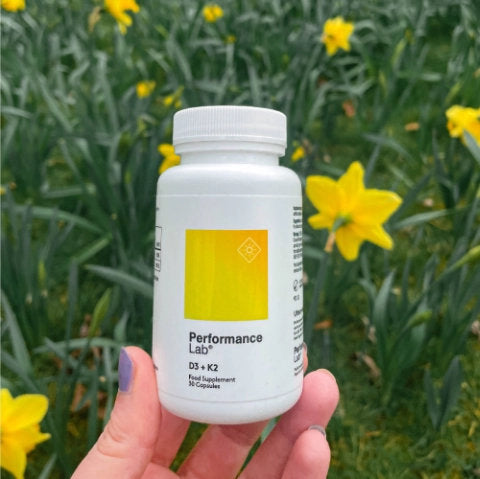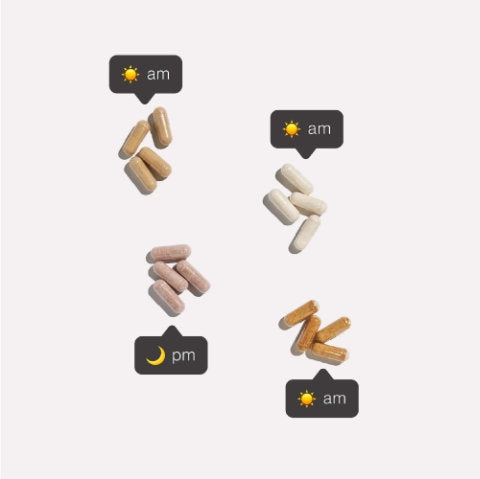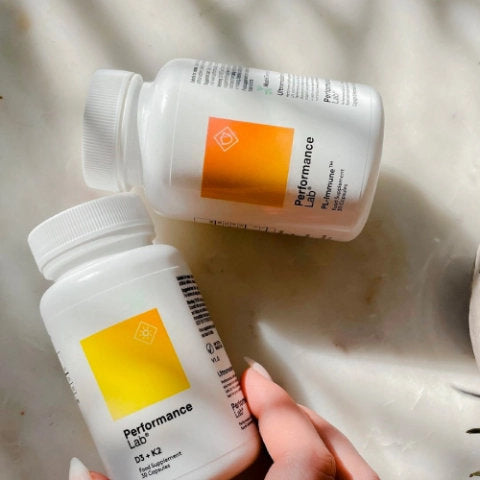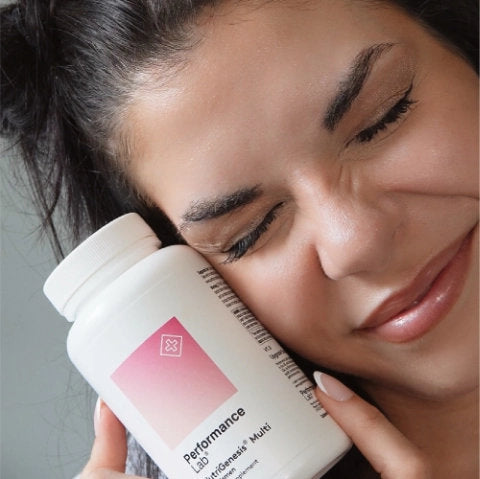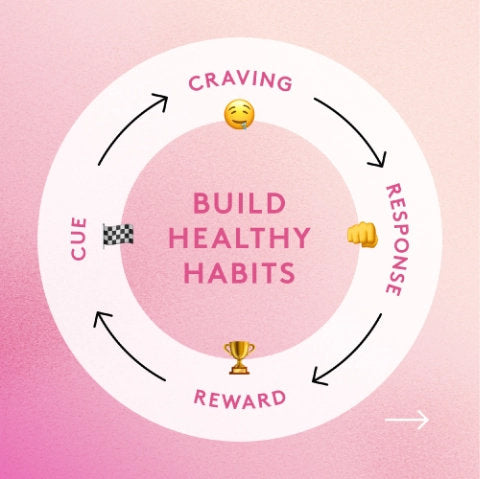Migraine attacks are no joke.
More than just a headache, they can be completely debilitating and difficult to get rid of.
If you’re prone to them, the chances are a well-intentioned friend has offered you some paracetamol to help. But depending on the severity, off-the-shelf painkillers often don’t quite hit the mark. Or hit anywhere near the mark.
Specific prescribed migraine medication is usually the only thing that will touch it.
That, along with a dark room, complete silence and a cold compress to numb the pain.
And while prescription medication is often essential for managing migraines, many people are also searching for proven natural options to complement their treatment plans and reduce reliance on medications over time.
Enter, riboflavin. Also known as vitamin B2 .
The good news is that there is solid research in humans to suggest that riboflavin supplements may be an effective treatment when it comes to natural ways to manage a migraine.
Key Takeaways
Not got time? Here are the highlights:
- Migraines Are More Than a Headache: Migraines involve severe head pain, sensitivity to light and sound, nausea, and other debilitating symptoms that can last from 4 hours to 3 days.
- Riboflavin Shows Promise: Clinical studies suggest that high-dose riboflavin (400 mg daily) can significantly reduce migraine frequency and severity by supporting mitochondrial function.
- Mitochondria Matter: Mitochondrial dysfunction—when cells can't produce enough energy—may be a key factor in migraines, making nutrients like riboflavin, CoQ10, and magnesium important for prevention.
- Beyond Riboflavin: Nutrients like magnesium, CoQ10, and other B vitamins also support mitochondrial health.
- Support Your Mitochondria Daily: Our Performance Lab® Multi , B-Complex , and Energy supplements provide targeted support for energy production, mental clarity, and long-term cellular health.
What Are Migraines?

As mentioned before, migraines are much more than a headache. More than even the worst headache you’ve ever had. Depending on the severity, they can be completely debilitating.
And it’s not just about that throbbing pain in your head. They often come with a collection of random nasty symptoms to go alongside that splitting headache.
Migraine Symptoms
These vary from person to person and can occur at different stages of the migraine. But all migraines tend to include all, or some of the following:
- Head pain typically on one side.
- Sensitivity to light, noise, and smell.
- Nausea and vomiting.
- Visual disturbances (aura) such as flashes, waviness, and blind spots.
- Lethargy.
What Causes a Migraine?
The causes aren’t fully understood. But they are thought to be triggered by a complex interaction of genetic, neurological, and environmental factors. Migraines can be caused by:
Sensory stimuli: Bright lights, flickering screens, loud noises, and strong smells.
Weather changes: Shifts in barometric pressure, humidity, or temperature may trigger attacks.
Genetics: Specific genes related to brain and vascular function, such as those affecting ion channels, have been linked to migraines. Often migraines run in the family, which suggests a genetic predisposition.
Hormonal influences: Estrogen fluctuations, HRT, and hormonal contraceptives have all been linked to migraines.
Neurotransmitter imbalances: Fluctuations in serotonin levels may also play a role in migraine susceptibility.
Diet: Red wine, excess caffeine, food additives like aspartame, and foods containing tyramine found in cheeses and smoked meats may be triggers. 1-4
Coexisting medical conditions: Migraines are often linked to other conditions such as depression, anxiety, chronic pain disorders, and sleep disorders. 5
How Long Do They Last?
Migraines can last anything between 4 hours and 3 days. There tend to be 3-4 separate and identifiable stages to a migraine.
The pre-migraine phase is known as the prodrome. This lasts anything from 2 hours to 2 days before the actual headache kicks in. Symptoms during this phase can be fatigue, mood change, food cravings, neck stiffness, or frequent yawning.
The aura stage, that 25-30% of migraine sufferers experience, usually happens 10 to 60 minutes before the headache begins. This stage may include flashes of light, tingling, blind spots, and even difficulty speaking.
The headache phase comes next. Often on one side of the head, but sometimes on both, this can last between 4 to 72 hours. It often feels like a pulsating sensation, and this is when sensitivity to light, noise, and smell kicks in.
The post-migraine phase is known as the postdrome. This lasts a few hours to a couple of days once the headache has subsided. During this period you may experience brain fog, fatigue, or a ‘hungover’ feeling.
What Evidence is There Behind Riboflavin and Migraines?
Multiple case studies and reviews have been carried out on riboflavin’s effect on migraines. The studies covered all age groups, but the ones listed below are specifically relevant to adults.
Study 1: 1998
A randomized controlled trial investigated the effectiveness of high-dose riboflavin (400 mg) for migraine prevention over three months.
This was based on the theory that migraines are linked to mitochondrial energy deficits.
The study compared riboflavin to a placebo in 55 patients and found that riboflavin significantly reduced migraine attack frequency and headache days.
59% of participants taking riboflavin experienced at least a 50% reduction in migraines. That’s compared to just 15% in the placebo group. 6
With this high level of efficacy, the study concluded that riboflavin stands out as a promising option for migraine prevention.
In fact, it worked so well that it warranted further comparison with established migraine medications such as triptans.
Study 2: 2004
Over a six-month period, an open-label study was carried out in a specialized outpatient clinic.
This means that, unlike double-blind, placebo-controlled studies, participants knew the identity of the treatment or drug they were taking.
Researchers observed a significant reduction in headache frequency, decreasing from 4 days per month at baseline to 2 days per month after 3 and 6 months of treatment.
Additionally, the study found that participants needed to take fewer migraine medications to stop their headaches during an attack. On average, they went from using these medications 7 times a month to using them only 4.5 times a month after starting the riboflavin treatment. 7
While the duration and intensity didn’t drop significantly, the study reinforces that riboflavin is a promising natural option when it comes to reducing the frequency of attacks.
Study 3: 2009
This study looked at whether genetics—specifically differences in mitochondrial DNA (mtDNA)—might affect how well high-dose riboflavin (400 mg daily) works for preventing migraines.
Researchers focused on a common mtDNA type called haplogroup H, known for its unique way of managing energy in cells. Over four months, 64 people with migraines took riboflavin, and their genetic profiles were analyzed.
The results were pretty striking: riboflavin worked better for people with non-H mtDNA, helping 67.5% of them, compared to only 33.3% of those with haplogroup H. 8
These findings suggest that genetic differences in how our cells manage energy might explain why riboflavin works better for some people than others. This opens the door to more tailored migraine treatments in the future, especially for populations where haplogroup H is more common, like in Europe.
The Verdict: Does Riboflavin Reduce Migraine Frequency?
The studies clearly show that high-dose riboflavin (400 mg) may be effective in reducing migraine frequency.
But it’s important to note that the therapeutic dose in these studies was 400 mg per day.
This high dose isn’t typically found in most dietary supplements.
However, riboflavin plays a vital role in overall energy production and cellular health, which can still be beneficial even at lower doses.
What’s really interesting is the link between riboflavin and energy production.
Could the key to managing migraines lie in supporting mitochondrial health as a whole?
Why Focus on Mitochondria?

The studies we’ve explored highlight a definite connection between migraines and mitochondrial function.
One of the leading theories in migraine research suggests that mitochondrial energy deficits—when the mitochondria in your cells can’t produce enough energy—might make the brain more susceptible to migraine triggers.
Think of it as trying to make a video call when the WiFi is really weak.
The picture freezes, the sound fragments, voices get distorted, and sometimes it cuts out completely.
Similarly, when your brain’s energy supply from the mitochondria is insufficient, it struggles to process sensory input smoothly.&
This “weak signal” might explain the heightened sensitivity to light, sound, and other triggers, as well as the disruptions that lead to a migraine attack.
Riboflavin and Mitochondria: Only Part of the Puzzle
Riboflavin (vitamin B2) plays a key role in supporting mitochondrial energy production.
It can be obtained through dietary riboflavin in foods like eggs, leafy greens, and almonds. Or, as indicated in the studies, through supplementation for higher doses.
As a precursor to two key coenzymes, FAD (flavin adenine dinucleotide) and FMN (flavin mononucleotide), riboflavin helps drive the processes that allow mitochondria to generate energy in the form of ATP.
In the context of migraine treatment, this ability to boost mitochondrial efficiency may explain why high doses (400 mg) of riboflavin have shown such promising results.
By tackling the energy deficits that make the brain more vulnerable, riboflavin is thought to fortify your cells’ ability to keep up with the brain’s energy demands.
That said, while riboflavin is a key player, it’s not the only nutrient mitochondria rely on to function efficiently.
Learn more about vitamin deficiencies and migraines
The Bigger Picture
CoQ10, magnesium, and B-complex vitamins are also essential for mitochondrial function. They facilitate the process by:
- Supporting the electron transport chain (the energy-production machinery inside mitochondria).
- Protecting against oxidative stress that can damage mitochondrial function.
- Enhancing overall cellular energy metabolism.
All of these nutrients complement riboflavin to offer a full team effort in supporting mitochondrial health.
Top Nutrients Proven to Help Relieve Migraines

Mitochondria, the "powerhouses" of our cells, rely on a range of nutrients to function efficiently and produce the energy ( ATP) that keeps our brains and bodies running smoothly.
Here are some other key nutrients that work alongside riboflavin to optimize mitochondrial health:
Coenzyme Q10 (CoQ10)
Role: CoQ10 is a critical component of the electron transport chain, where ATP is produced. It also acts as a powerful antioxidant, protecting mitochondria from damage caused by oxidative stress.
Research: A study found that CoQ10 supplementation significantly reduced migraine frequency and severity over three months, with migraine days dropping from 7.34 to 2.95 per month (P < 0.0001). Over half of participants improved. 9
Takeaway: CoQ10 complements riboflavin by enhancing energy production and reducing mitochondrial damage.
Magnesium
Role: Magnesium is essential for numerous enzymatic reactions in mitochondria, including those involved in energy production. It also helps regulate nerve function and prevent the overactivation of brain pathways linked to migraines.
Research: A 2021 randomized, double-blind, crossover study compared the effectiveness of magnesium oxide (500 mg/day) to valproate sodium (400 mg/day) in preventing migraines over a 24-week period. 10
Both treatments significantly reduced the number of migraine attacks and days with moderate or severe headaches compared to baseline.
Takeaway: Magnesium not only supports mitochondrial function but also directly addresses a common deficiency linked to migraines.
B-Complex
Role: Beyond riboflavin, other B vitamins like B6 (pyridoxine) and B12 (cobalamin) play supporting roles in energy metabolism and neurological function. B6 is required for neurotransmitter production, while B12 helps protect nerves and supports red blood cell formation for efficient oxygen delivery.
Research: A 2022 double-blind, placebo-controlled trial assessed the effects of B vitamins (B1, B6, B12, B9, and a B-complex) on women with episodic migraines over 12 weeks. 11
Among 120 participants, all vitamin groups significantly reduced headache frequency ( P < 0.001), improved Migraine Disability Scores (MIDAS) ( P < 0.001), and decreased abortive medication use ( P = 0.032) compared to placebo.
Takeaway: Together, B vitamins create a synergistic effect, supporting energy metabolism and overall neurological health.
Folate (Vitamin B9)
Role: Folate helps lower homocysteine levels, which are linked to migraines, particularly in individuals with the MTHFR gene variant. It supports brain and vascular health.
Research: A study on women with migraines with aura found that higher folate intake significantly reduced migraine frequency ( P < 0.045), with greater effects in those with the MTHFR CC genotype ( P < 0.029).
Takeaway: Folate may help reduce migraine frequency, especially in people with genetic predispositions like the MTHFR variant.
These nutrients work together to give your mitochondria the support they need to do their job.
While riboflavin gets most of the spotlight in migraine research, nutrients like CoQ10, magnesium, and other B vitamins are just as important for keeping your mitochondria—and your brain—running smoothly.
Final Thoughts: Riboflavin, Mitochondria, and Migraine Relief
Migraines are complex, and there’s a lot more research needed to fully understand the causes and cures.
But their connection to mitochondrial health offers a promising area for prevention and management. While riboflavin has shown significant potential in clinical studies, it’s clear that supporting your mitochondria as a whole can be a game-changer—not just for migraines but for energy, mental clarity, and overall well-being.
The good news is, taking care of your mitochondria doesn’t have to be complicated. It starts with understanding the nutrients they rely on and incorporating them into your daily routine.
If you’re looking to optimize mitochondrial health and support migraine prevention, here are some products from our range that can help:
Performance Lab® Multi

Performance Lab® Multi:
- Includes riboflavin, magnesium, and a full spectrum of essential vitamins and minerals.
- Provides baseline daily support for energy metabolism, nervous system health, and overall vitality.
- Ideal for those looking for a well-rounded approach to health.
Shop Performance Lab® NutriGenesis®
Performance Lab® B-Complex

Performance Lab® B-Complex:
- Supplies bioavailable B vitamins in food-identical forms, including riboflavin, B6, B12, and folate.
- Supports energy production, cognitive function, and psychological health.
- A perfect option for addressing the daily demands of stress, physical activity, and modern lifestyles.
Shop Performance Lab® B-Complex
Performance Lab® Energy

Performance Lab® Energy:
- Combines advanced mitochondrial boosters like CoQ10, PQQ, and R-Lipoic Acid.
- Optimizes mitochondrial function for clean, crash-free energy without caffeine or synthetic additives.
- Helps protect mitochondria from damage, promoting long-term cellular vitality.
Riboflavin: Cure or Con?
So, is riboflavin a cure or a con?
The evidence shows that riboflavin isn’t a “cure” but rather an effective tool in the broader strategy of managing migraines.
At a higher dose of 400 mg, there’s good evidence to suggest that the frequency of migraine attacks, and the reliance on migraine medication, is reduced.
It also demonstrates that riboflavin works best when paired with other nutrients and a healthy lifestyle to support mitochondrial function.
Focusing on mitochondrial health is going to give your body the tools it needs to step up against the triggers that cause migraines. And the double win is that this is going to support healthy function in all other areas too.
Take care of your mitochondria, and they’ll take care of you.
- Littlewood JT, Gibb C, Glover V, Sandler M, Davies PT, Rose FC. Red wine as a cause of migraine. Lancet. 1988 Mar 12;1(8585):558-9. doi: 10.1016/s0140-6736(88)91353-0. PMID: 2894493.
- Zduńska A, Cegielska J, Zduński S, Domitrz I. Caffeine for Headaches: Helpful or Harmful? A Brief Review of the Literature. Nutrients. 2023 Jul 17;15(14):3170. doi: 10.3390/nu15143170. PMID: 37513588; PMCID: PMC10385675.
- Lipton RB, Newman LC, Cohen JS, Solomon S. Aspartame as a dietary trigger of headache. Headache. 1989 Feb;29(2):90-2. doi: 10.1111/j.1526-4610.1989.hed2902090.x. PMID: 2708042.
- Moffett A, Swash M, Scott DF. Effect of tyramine in migraine: a double-blind study. J Neurol Neurosurg Psychiatry. 1972 Aug;35(4):496-9. doi: 10.1136/jnnp.35.4.496. PMID: 4559027; PMCID: PMC494110.
- Buse, D.C., Reed, M.L., Fanning, K.M. et al. Comorbid and co-occurring conditions in migraine and associated risk of increasing headache pain intensity and headache frequency: results of the migraine in America symptoms and treatment (MAST) study. J Headache Pain 21, 23 (2020). https://doi.org/10.1186/s10194-020-1084-y
- Schoenen J, Jacquy J, Lenaerts M. Effectiveness of high-dose riboflavin in migraine prophylaxis. A randomized controlled trial. Neurology. 1998 Feb;50(2):466-70. doi: 10.1212/wnl.50.2.466. PMID: 9484373.
- Boehnke C, Reuter U, Flach U, Schuh-Hofer S, Einhäupl KM, Arnold G. High-dose riboflavin treatment is efficacious in migraine prophylaxis: an open study in a tertiary care centre. Eur J Neurol. 2004 Jul;11(7):475-7. doi: 10.1111/j.1468-1331.2004.00813.x. PMID: 15257686.
- Di Lorenzo C, Pierelli F, Coppola G, Grieco GS, Rengo C, Ciccolella M, Magis D, Bolla M, Casali C, Santorelli FM, Schoenen J. Mitochondrial DNA haplogroups influence the therapeutic response to riboflavin in migraineurs. Neurology. 2009 May 5;72(18):1588-94. doi: 10.1212/WNL.0b013e3181a41269. PMID: 19414726.
- Rozen TD, Oshinsky ML, Gebeline CA, Bradley KC, Young WB, Shechter AL, Silberstein SD. Open label trial of coenzyme Q10 as a migraine preventive. Cephalalgia. 2002 Mar;22(2):137-41. doi: 10.1046/j.1468-2982.2002.00335.x. PMID: 11972582.
- Karimi N, Razian A, Heidari M. The efficacy of magnesium oxide and sodium valproate in prevention of migraine headache: a randomized, controlled, double-blind, crossover study. Acta Neurol Belg. 2021 Feb;121(1):167-173. doi: 10.1007/s13760-019-01101-x. Epub 2019 Feb 23. PMID: 30798472.
- Nematgorgani S, Razeghi-Jahromi S, Jafari E, Togha M, Rafiee P, Ghorbani Z, Ahmadi ZS, Baigi V. B vitamins and their combination could reduce migraine headaches: A randomized double-blind controlled trial. Curr J Neurol. 2022 Apr 4;21(2):105-118. doi: 10.18502/cjn.v21i2.10494. PMID: 38011468; PMCID: PMC9860208.





